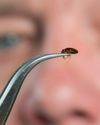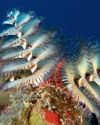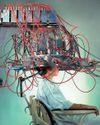
“You could administer antibody treatments to people who are infected, and it would reduce the disease burden.”
What is a spike protein and what is its function?
Daniel Wrapp A spike protein is a protein that decorates the surface of a coronavirus. Its job is to attach that virus to a host cell by binding to a receptor [on the host cell’s surface]. Once it’s attached, it fuses the viral membrane with the host cell membrane so that the virus can enter into the host cell and begin the process of replication. The spike protein is the main machine that the virus uses to enter into our cells. So, without the spike functioning properly on the surface of a virus, the virus is neutralised and is noninfectious.
Why did you focus on llamas?
Camelids, which is a family that includes camels, llamas, alpacas and a couple of other animals, produce this special class of small antibodies [proteins produced by the immune system to fight off harmful bacteria and viruses], which are sometimes called nanobodies. Camelid antibodies are about half the size of the conventional antibodies that you or I would produce, and because of that small size, they have enhanced stability and they’re also capable of binding to small crevices or pockets that larger antibodies wouldn’t otherwise be able to bind to. [This is why the llama antibodies can bind to the spike proteins on coronaviruses.]
Bu hikaye Very Interesting dergisinin November/December 2020 sayısından alınmıştır.
Start your 7-day Magzter GOLD free trial to access thousands of curated premium stories, and 9,000+ magazines and newspapers.
Already a subscriber ? Giriş Yap
Bu hikaye Very Interesting dergisinin November/December 2020 sayısından alınmıştır.
Start your 7-day Magzter GOLD free trial to access thousands of curated premium stories, and 9,000+ magazines and newspapers.
Already a subscriber? Giriş Yap

TAKE IT SLOW
Slow running is a fitness trend with some hard and fast science behind it

Physics, AI and music share a common thread. You just have to know where to look
Studying science can lead you in many directions and open doors to unexpected possibilities along the way

BED BUGS VS THE WORLD
When bloodthirsty bed bugs made headlines for infesting Paris Fashion Week in 2023, it shone a spotlight on a problem that's been making experts itch for decades: the arms race going on between bed bugs and humans

Kids are the key to understanding obesity. But we need more of their genes...
We can unravel the role that bodyweight plays in disease, but we need a bigger, more diverse, sample of genetic material to do so

COVID inquiry: What did we learn and what can we do better in future pandemics?
Masks, social distancing, lockdowns... how effective was the UK's response to the COVID-19 pandemic?

One hormone could be the key that unlocks a cure for morning sickness
The nausea and vomiting that, in extreme cases, can endanger mothers and babies might soon be just a memory

THE WORLD'S WEIRDEST CREATURES
Under the sea and upon the land, some animals look - to us - pretty strange...

WHEN MIND AND MACHINE COLLIDE
First, Elon Musk wanted to make electric cars ubiquitous, then he wanted to make space exploration a private enterprise. Now, with Neuralink, his newest venture, Musk hopes to merge humans and artificial intelligence. Turns out, it might not be such a crazy idea...

COME OUT OF YOUR SHELL
Social anxiety is more than just being shy. It's a phobia born out of our evolutionary past. But that raises a puzzling question: why do so many of us fear human interaction when we're supposed to be the most sociable species on the planet?

SPACE ODDITIES
Take a tour of the weirdest spots in the universe, where the 'normal' rules don't apply. Places that squeeze time, blow bubbles and even rain glass... sideways